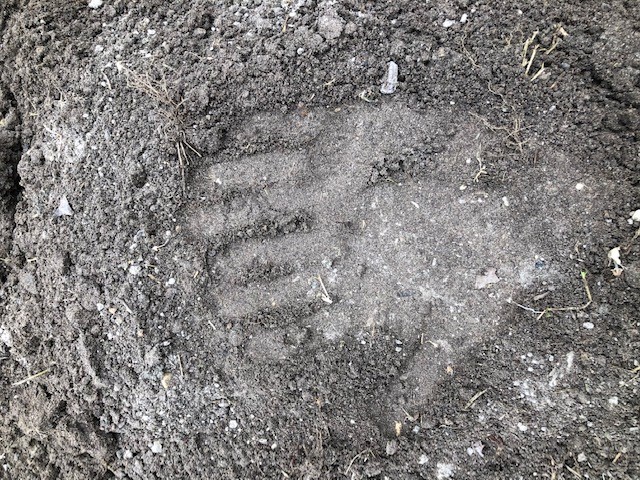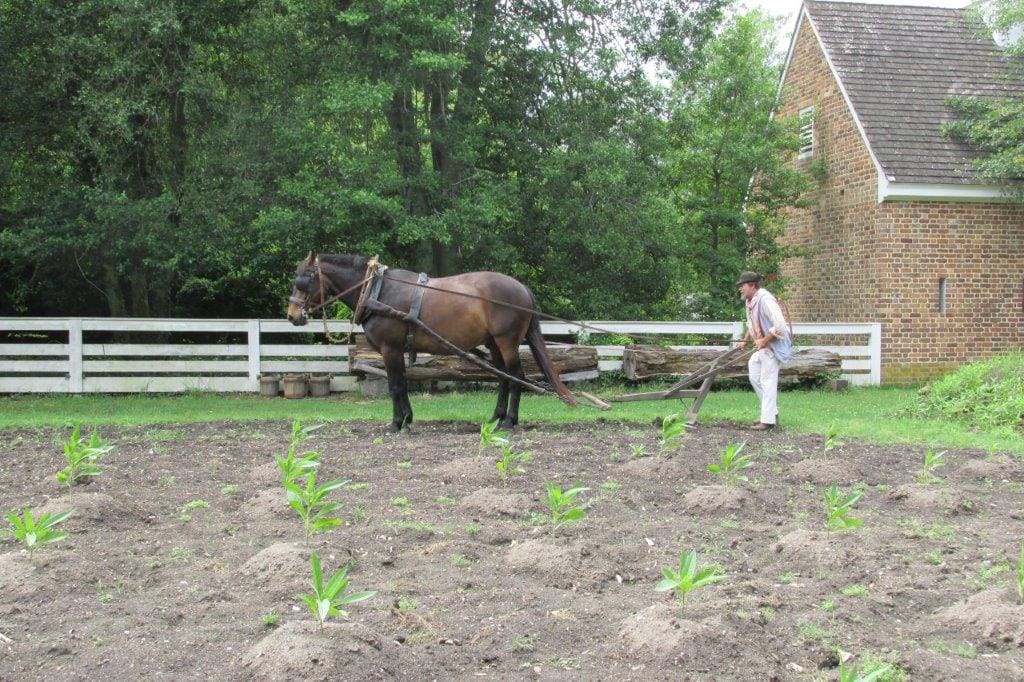Thoughts of a Farmer Part I: Soil Preparation and Planting Crops
There is a lot of hard work that must take place to grow crops. The soil must be properly prepared and the seeds planted. This is straight forward stuff - diligent labor gets the work done. 18th-century planter Richard Corbin explained this in a letter to James Semple as “The ways of industry are constant, not to be in a hurry at one time and do nothing at another, but to be always usefully and steadily employed”. In other words: steady hard work gets results. There is something else though. And only through doing the work could I fully come to understand it.

It all starts with preparing the soil so that it may receive the seeds. Nicely
tilled land provides soil contact with the seeds and allows them to germinate. Hard ground or clods of dirt just will not do.
In the Historic Farming Trade, this is accomplished by plowing. The mechanical action of the implement slices off the soil and turns it over. This is pleasant work and the rich smell of the soil and the scouring sound of the soil moving is compelling.
The plow is pulled by draft animals. Oxen are strong and steady, but it takes two people committed to do the job - a driver for the oxen and another person guiding the plow. But with horses, the job can be done with one person driving both the horse and holding the plow. Less human labor is needed to accomplish the same task using a horse and labor is a key component of farming.


But what if the land was still forest? Some of the land in the early years of Virginia’s settlement had been tilled by Native Americans for centuries. Yet, much had never been worked in the history of humankind. I have often imagined what it must have been like to stand with an axe in hand while looking at an expanse of unbroken timber. But then I think of the richness of the soil underneath! If only one could get to it.
What I did not realize at first was that on the other hand there must have been a firebrand. The axe is used to cut around the outer layer of the trees thus killing them. Eventually, fire is used to burn the dead trees. Today, we call this method Slash and Burn, and the process is still used around the world to clear land.
A plow cannot be used to loosen the soil in this burned over landscape. The remaining roots of the trees would catch the point of the plow and stop it every few feet. The only method remaining was to chop the soil up with a hoe, a process called grubbing. Thomas Jefferson- always a man of detail- noted in his Farm Book in 1772 that “a laborer will grub from half an acre to an acre a week of common bushy land in winter.”
Twenty-six years later in 1798, we see the same method employed in the image below as enslaved women loosen up the ground with hoes. Disregarding the overseer standing on the stump, notice the burning brush in the background.

The land is all a jumble now from the disturbance of the plow or hoe. Clods and chunks abound. Seeds do not get enough soil contact to germinate in this mess so one more tilling is needed with a harrow. This implement is dragged behind oxen or horses while the protruding teeth pulverize and level the land.

This can be rough going sometimes as the picture below indicates. Walking over big chunks of dirt is tiring work!

After the land is broken down to a loose and well pulverized soil, it is ready to receive the seed. Planting wheat is easy as the seed is cast upon the tilled ground and “raked” in with a harrow. But with crops like tobacco, corn, and cotton- a hill is first raised with a hoe.
Many guests have asked me why plant in a hill? Putting a fish within for fertilizer is not the reason and was not done here in the Tidewater region of Virginia. Some ask if these crops will grow if planted directly in the ground? Absolutely. Why do we do it then?
Two reasons: It Works and Tradition. If a farmer’s parents, grandparents and great-grandparents and before that the Indians did it this way and it worked then why change? Tradition abides when a method works and 18th century farmers were slow to change their methods.
It takes an adult about 10-14 strokes of the hoe to raise a hill about 18 inches wide and near a foot high. It is “dabbed” flat after that to pack the soil. The hills are on a grid-like pattern between three to six foot apart.
After raising hills, they are planted with a young tobacco plant or in the case of corn and cotton- by seed. Finally, after plowing or grubbing the land with a hoe and then harrowing and raising hills, the crops are planted! The “ways of industry” as Richard Corbin put it are definitely “constant”.

In the beginning of this blog, I mentioned that soil preparation and planting was a lot of work and now you can understand why. It takes steady and diligent labor by both humans and draft animals. There are intangible aspects though that can only be learned by doing. One is perseverance. Continually striving to accomplish all these tasks. Pushing on despite all obstacles. But there is something else and it eluded me for the longest time.
Over the years, I have seen verdant growth of crops and tremendous yields of bushels of corn and wheat and a satisfying tobacco barn full of healthy green leaves. But I have also experienced tobacco scorched and withered by drought and corn laid flat from a hurricane. Such reward… but sometimes loss. And after so much hard work.
Reading period 18th-century diaries and journals, many write about their disappointments and triumphs in farming. They persevered no matter what. I have felt the same in my labors to make a good crop. But there still seemed like there was something else. Not satisfied with the written word, I sought the spoken. The essential fabric of a farmer has not changed, so for several years I asked every farmer that I met what it is like to put in so much work and sometimes not have a good harvest. Most just accepted it as part of farming. I wanted more though and was finally enlightened when Pennsylvania farmer and longtime Colonial Williamsburg guest Bill Swailes answered me: “Ed, every year- we plant Hope into the ground.”
Hope and Perseverance. That’s what farming is all about.
Ed Schultz has worked as a historic farmer for 30 years with this being his 18th year at Colonial Williamsburg. After serving as a U.S. Army paratrooper, he earned a Bachelor's degree in History and a Masters in Outdoor Museum Management. In 2019, he was awarded the Association of Living History, Farms and Agricultural Museums (ALHFAM) lifetime achievement award. He also works a small home farm with his family in the marshes of the Guinea Neck on the Chesapeake Bay.
Resources
Carter, Landon. The diary of Landon Carter of Sabine Hall, 1752-1778. Edited by Jack Greene. Charlottesville: University Press of Virginia, 1965.
Gray, Lewis Cecil. 1958. History of Agriculture in the Southern United States To 1860, Volume II. Gloucester, Massachusetts: Peter Smith.
Jefferson, Thomas. Thomas Jefferson’s Farm Book. Edited by Edwin Morris Betts. Charlottesville, University Press of Virginia, 1987.
